|
| On a 4-1 vote last Thursday, December 17, the California Public Utility Commission (CPUC) made it more expensive for many Californians to purchase renewable energy, by awarding PG&E the best Christmas present of all, a 95% increase in the Power Charge Indifference Adjustment (PCIA).
The PG&E exit fee is now the highest it has ever been, resulting in an average MCE customer paying $156 per year and in total resulting in approximately $36 million being collected by PG&E from MCE customers in 2016. This increase was approved, despite overwhelming statewide advocacy urging the CPUC to limit the fee.
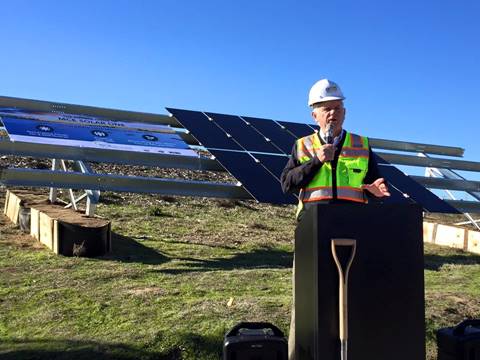
The day before the CPUC decision on PCIA, there was a groundbreaking for a 10.5 megawatt solar project in Richmond sponsored by the City of Richmond and MCE. Now Richmond ratepayers will have to pay more for electricity generated locally.
Since the Proposed Decision was issued on November 13th, there has been an astonishing outpouring of engagement and concern on this significant rate hike. Community members have “deluged” CPUC Commissioner Mike Florio, the assigned Commissioner to this case, with what he called “an unmanageable influx of emails.”
A number of our own MCE member communities have written the CPUC and also passed Resolutions opposing the proposed increase to the PCIA exit fee. There has also been robust support in the legislature from representatives of MCE service territory as well as Assembly Speaker Pro Tempore Mullin. Our CCA partners throughout the state held numerous meetings with Commissioners. The need to scrutinize the PCIA exit fee was not only urged by the editorial board of the San Francisco Chronicle, but an article about the issue was put on the front page. Most significantly, the CPUC has heard from hundreds of ratepayers and CCA advocates insisting that the CPUC ends business as usual and takes a deep look into the PCIA.
There was a remarkable turnout of speakers and community supporters at the press conference organized by LEAN. More than forty five passionate speakers came to speak directly to the CPUC to oppose the increase in PCIA.
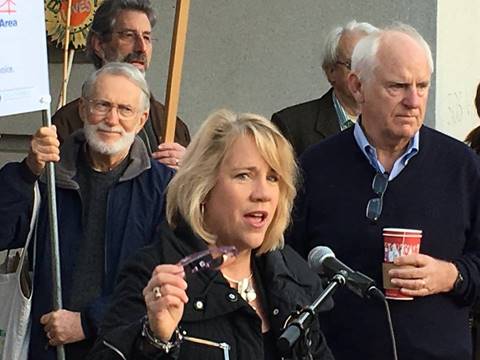
Shawn Marshall of LEAN Energy and Tom Butt of MCE at press conference at CPUC on December 17 to rally against the PCIA
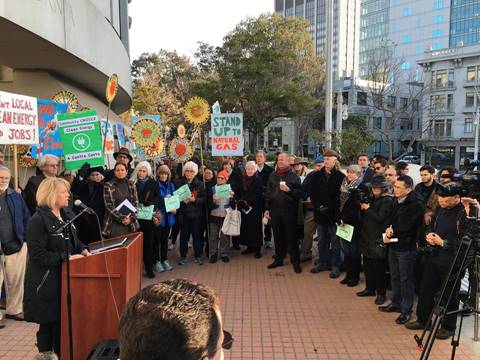
Commissioner Sandoval proposed two amendments that would have mitigated the PCIA rate hike; those proposed amendments were rejected by the other four Commissioners.
Apparently, the CPUC is suffering a disconnect from Governor Brown’s goal to provide 50% of California’s electricity from renewable resources by 2030. Governor Brown, who appoints members of the CPUC, was recently in Paris at the UN Conference on Climate Change touting California’s leadership in reducing greenhouse gases, but back home his appointees are busy manufacturing roadblocks.
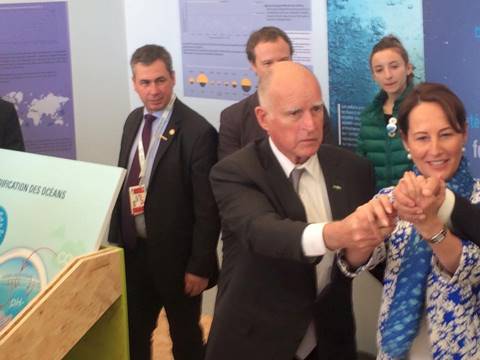
Governor Jerry Brown in Paris signing an MOU with governors from Vermont and Washington
The CPUC, already suffering from a reputation of being too cozy with the investor owned utilities, like PG&E, proved that they want to keep that reputation intact.
Community Choice Aggregation (CCA), provided by a growing number of local government agencies in California, is an opportunity for individual consumers to make a choice for renewable energy, but in order to have the best chance of working, the cost should be at least competitive with the cost of energy with a lesser renewable component from investor owned utilities.
Currently, green energy is actually cheaper than energy produced from fossil fuels, but the CPUC is making sure that will change by adding the PCIA surcharge.
One of the problems with California energy policy is that it lacks a unified management and regulatory scheme. Everything is in silos, and they are not necessarily connected. Perhaps the CPUC is the most disconnected of all.
The unfortunate CPUC decision on PCIA happened one day after the CPUC released a draft climate change policy, stating it will develop policies that support the state’s ambitious climate and energy goals. Commissioners and their staff are not currently required to factor greenhouse gas emissions impacts into energy policy decisions affecting California’s electricity sector, like they do with reliability, safety, and affordability. While this is a step forward, it does not specify what kind of policies the Commission plans to use to support the state’s pollution reduction goals.
Ironically, the primary argument by the CPUC and PG&E for PCIA is to avoid unfairly saddling bundled (read non-CCA) ratepayers with costs of benefits enjoyed only by CCAs. However, PG&E has no problem saddling all its ratepayers with subsidizing the cost of energy for PG&E employees, who are entitled to a 25% discount on their energy bill--a fact that seems relatively unknown by most members of the rate-paying public.
Here is what PG&E says about it: http://spd.mypgebenefits.com/mat/pge-9a0-work-life-eds-mgmt-web-j.html. We bring this up for a couple reasons:
- Fairness -- It seems problematic for PG&E to extract millions of dollars in PCIA fees (even from low-income customers) while it simultaneously gives a 25% discount to its employees without any adjustment socio-economic status.
- Why should PG&E executives receive a discount on their energy (presumably subsidized by ratepayers) while they're proposing to raise PCIA fees by 95% on CARE customers, local non-profits, public school districts, houses of worship, military veterans, et. al.?
- Energy Efficiency & GHG reduction -- A discount to thousands of well-paid consumers creates an obvious disincentive to conserve;
- Rate competitiveness -- A selective discount of this size & scope presents a burden to bundled customers, and contradicts PG&E's assertions that affordability and rate competitiveness is a priority.
- Also, this discount helps explain how MCE and other CCAs can offer competitive rates, while providing substantially higher levels of renewable energy. In other words, MCE can offer more renewable energy at competitive rates because (among other things) our agency does not use ratepayer dollars to subsidize its employees' energy consumption;
- Ratepayer advocacy -- Very few people know about this discount. We have yet to ask a single person who realized it was baked into their utility costs (other than friends who work for PG&E).
- Why not reduce the discount to 10% (or 5%) for all employees earning above $100,000/yr (or $90,000/yr), and use the revenue savings to provide relief to CCA CARE customers?
Following are a number of articles and editorials about the CPUC decision:
Tom Butt
Customers of clean energy programs hit with fee increase
By Lizzie Johnson
Updated 7:53 pm, Thursday, December 17, 2015
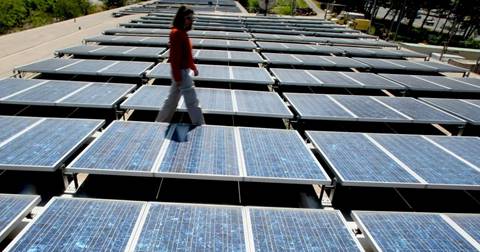
Photo: Lacy Atkins, SFC
PG&E and other big utilities also proposed cutting the amount of compensation that solar homeowners receive for excess electricity that they export to the grid.
The California Public Utilities Commission voted Thursday to allow a nearly 100 percent price increase on exit fees for customers leaving Pacific Gas and Electric Co. for green energy programs like CleanPowerSF and Marin Clean Energy, which will make those and similar programs more expensive.
Many of the programs — where local governments buy green electricity for their residents, while private utilities own and operate the electrical grid — will be undermined financially by the uptick in the charge, called the Power Charge Indifference Adjustment, their officials say.
“We are not surprised that the increase was approved,” said Marin Clean Energy spokeswoman Alexandra McCroskey. “We are disappointed. Our primary frustrations come from the fact that we are becoming almost liable for the market fluctuations for both ourselves and PG&E. If PG&E isn’t planning appropriately for people leaving for community choice aggregation programs, the PCIA will continue to increase. It’s poor planning.”
Under the increase, which is effective Jan. 1, customers making the switch to local green energy programs will face a heftier exit fee. Marin Clean Energy customers are projected to pay more than $36 million, up from $19.3 million in 2015. The cost for each residential customer would nearly double from about $6.70 each month to $13.
In San Francisco, the proposed exit fee for residents moving to CleanPowerSF would jump by 100.26 percent. Because the city energy program is designed to absorb costs for its customers, it would decrease the program’s revenue by $8.4 million.
Win for consumers
This month, PG&E and other big utilities also proposed cutting the amount of compensation that solar homeowners receive for excess electricity that they export to the grid, in addition to adding new monthly fees targeting solar homeowners. The CPUC released a proposed decision on the matter this week rejecting the fees. A vote is scheduled for January.
“Overall, we didn’t convince three commissioners to rule our way on the PCIA,” said Barbara Hale, assistant general manager for power at the San Francisco Public Utilities Commission. “The fee is going to double, and that’s tough for us. But we are marching forward with our CleanPowerSF program, which will launch this spring. We are still moving forward.”
Hundreds of protesters came from as far as San Diego to oppose the fee increase at Thursday’s meeting in San Francisco. They carried homemade signs reading “Stand Up to Natural Gas!” and “CPUC: Consumers Pay Again?!” Public comment on the change stretched for more than two hours.
“We’ve achieved a great deal, but there is this overhang of costs that were necessary to kick-start the industry,” said CPUC Commissioner Mike Florio. “The reason the PCIA is so high is because of high-cost renewable contracts that PG&E was required by law to enter into, and that this commission approved. I don’t think it’s fair to let one group of customers escape from paying those historic costs and simply load those on the remaining customers. That’s what the PCIA is all about.”
Charge required by law
PG&E originally filed an application to raise the fee by 70 percent in June, but submitted another request last month to as much as double it. The fee helps the power company pay for energy it contracted for when it had more customers, preventing remaining patrons from bearing the brunt of the costs. The charge is required by law and determined by a formula implemented by the CPUC in 2011.
The fee is influenced by several market factors, including the price of energy, which fluctuates from year to year, said David Rubin, PG&E’s director of service analysis. The cost of power is now cheaper, meaning the difference between what PG&E paid for in its contracts and the price today is higher.
“The PCIA is going up because it is based very specifically on the difference between the cost of supplies in our portfolio which are based on contracts we signed several years ago when renewable prices were higher,” Rubin said. “If dynamics were different, the PCIA would go down.”
Process has critics
PG&E performs the calculation annually and submits the annual filing to the commission for approval. But to calculate the fee increase, some of the inputs must include confidential contract information. Critics say the numbers going into this ‘black box’ prevent outsiders from replicating the formula, and that the increase is another attempt by PG&E to undermine fledgling green energy programs, like Peninsula Clean Energy, which will provide electricity in San Mateo County beginning in August.
“The fee is almost completely redacted,” said Francesca Vietor, president of the San Francisco PUC. “It is extremely difficult for us to know what an affordable rate for our program is when we don’t have a transparent process.”
The CPUC also ordered in its decision that a workshop be held on Feb. 16 to address the methodologies and inputs used for calculating the PCIA charge.
“One day you’re a hero, the next day you’re a goat,” CPUC President Michael Picker said. “We are in the nature of balancing decisions. But we will continue to scrutinize the PCIA formula and balance different interests equally.”
Lizzie Johnson is a San Francisco Chronicle staff writer. E-mail: ljohnson@sfchronicle.com Twitter: @lizziejohnsonnn
Renewable energy rate-battle is CPUC’s chance to prove it’s not in PG&E’s pocket

If the CPUC approves a fee for customers leaving PG&E, programs like CleanPowerSF may have to eat the cost. (s.f. examiner file photo)
By Joe Fitzgerald Rodriguez on December 15, 2015 1:00 am

Our hot world is working to cool down, together.
In Paris, international leaders broke into tears over an agreement to reduce carbon emissions. Did the agreement go far enough to save our environment? Probably not.
Still, some are calling the deal “historic.” And, at least, it’s a step forward.
However, on the eve of those talks, here in famously liberal San Francisco, we may soon “historically” blunder backwards on climate change.
The California Public Utilities Commission is set to approve a set of rate calculations from Pacific Gas & Electric, Co. Buried in dense regulator-ese is a provision to adopt what’s called the “Power Change Indifference Amount.”
In plain English, it’s a provision to jack up the price customers pay to join renewable energy programs sponsored by cities. In San Francisco, that’s CleanPowerSF, which may launch as soon as next year.
This may stunt renewable energy programs in Marin, Sonoma and any city that may soon offer such programs.
If you’re a customer of PG&E, you now pay an “exit fee” to drop PG&E and join a community choice aggregation program, in which cities provide renewable energy to their citizens. This decision may send those exit fees through the roof, by nearly 95 percent.
PG&E is no doubt jacking the fees to protect their once-monopoly on California energy.
The consumer will never see this fee, but that’s only because community choice aggregation programs like CleanPowerSF will eat the cost — and the effect it will have on the program itself is damning.
Jason Fried, executive officer of the Local Agency Formation Commission, told On Guard the exit fee may cost CleanPowerSF as much as $8.5 million in the next five years.
“That’s millions that could’ve been spent on the buildout,” he told me.
The money would create jobs building out solar panels, wind turbines and energy of the hippie-dippy planet-saving variety. Whereas CleanPowerSF may have seen its power mix become 50 percent renewable in the coming years, now the program may have to scale back to 33 percent renewable in the near future, Fried said.
That’s still more clean and green than PG&E, but it’ll delay CleanPowerSF’s lofty plans — and every year counts in our rapidly warming world.
The decision is also a test for a regulator that’s shown itself to be a dozing watchdog.
The CPUC’s “love letters” to PG&E are well documented — especially despicable when seen in the light of a PG&E-produced fireball that destroyed a part of San Bruno, killing eight.
Disgraced CPUC President Michael Peevey stepped down, and Michael Picker is now steering the regulator in a new direction. But the president wasn’t the only one blowing kisses PG&E’s way.
Emails revealed in the last month by the city of San Bruno show commissioner Mark Florio, who is still somehow shockingly sitting on the commission, was particularly close to PG&E.
“Amazing how I’ve been ‘an apologist for PG&E’ in just three years, isn’t it,” Florio wrote in a 2011 email, as the San Jose Mercury News revealed.
San Bruno City Manager Connie Jackson told On Guard, “Mr. Florio has demonstrated he is concerned PG&E gets what it wants, whether it’s in the public’s interest or not.”
We asked the CPUC for comment, but received no answers by press time.
Now Picker and the commission are facing an early test of their “new direction” — raising “exit fees” on state renewable energy programs may show if CPUC will kow-tow to PG&E again.
State Sen. Mark Leno, D-San Francisco, tried to reform this shady relationship, only to see his bill vetoed by Gov. Jerry Brown (“moonbeam,” indeed). Leno penned a letter to the CPUC decrying the vote to raise prices on the PG&E exit fees.
Speaking to On Guard, Leno said the CPUC’s job “is to scrutinize the utilities presentations in these rate setting cases, and be there to protect the consumer.”
“We’re just asking them to do the job they’ve been given to do,” he said.
Come Thursday, we’ll see if the CPUC is still a smooching watchdog, or if it has bite.
On Guard prints the news and raises hell each week. Email him at joe@sfexaminer.com.
PG&E’s huge profit from exit fee signals need for reformBy Mark Leno and Francesca Vietor
December 14, 2015
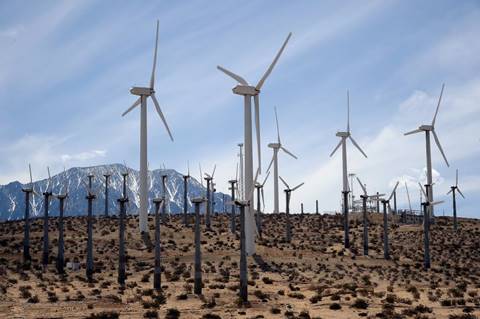
Photo: Kevork Djansezian, Getty Images
Giant wind turbines are powered by strong winds on March 27, 2013 in Palm Springs, California. According to reports, California continues its lead in green technology and has the lowest GHG emissions per capita, in the Nation.
When customers leave PG&E’s electric generation service, they are assessed a permanent, ongoing exit fee. No one disputes that an exit fee paid to utilities, if appropriately administered, can be a fair way to equitably reimburse existing electric customers when others leave for cleaner energy from programs such as Marin Clean Energy, Sonoma Clean Power, or forthcoming programs such as CleanPowerSF or Peninsula Clean Energy.
What is at issue is why the California Public Utilities Commission is not asking questions expected of an oversight body or engaging in a transparent public process in this important decision. We request that the state commission reject the PG&E proposal to double the exit fee when it votes on Thursday until the commissioners can audit PG&E’s proposed rate increase and revisit the fairness of the calculation of the fee, known as the Power Charge Indifference Adjustment.
Until that audit and public discourse has taken place, we propose that the commission temporarily cap any such increases requested by the utility. The commission should then convene a series of public workshops and attempt to create a fair and balanced process that provides equity for customers who choose to remain with PG&E and for those who choose a cleaner future through community choice aggregation programs.
If PG&E’s proposed increase to $13 from $6.70 a month is approved, it would stifle efforts of California cities to receive cleaner electricity and disproportionately charge higher fees to the poorest households. California cities and counties, energy advocates and environmental organizations are demanding that the commission enforce its own rate-making rules by taking the time to properly audit and discuss PG&E’s rate proposal.
A system that has allowed PG&E to stockpile $1 billion in profit off the backs of “exiting” customers is a red flag that the calculation is out of balance and in need of major overhaul. When PG&E takes the exit fee, it still has the ability to sell the power at a profit that the exiting customer would have used. Further, under the current system, PG&E collects the exit fee in perpetuity. The utility has not been required to reimburse those exiting customers their fee when there was no loss. Instead of allowing PG&E to roll the exit fee into its budget, the commission should require the utility to reimburse exiting customers.
The commission cannot simply trust the calculations of PG&E, nor expect the public to do so, when the data behind the calculations is kept secret.
It is clear that the 100 percent increase in the charge is aimed at targeting the clean power programs seeking to expand renewable energy generation. Failure to reject this proposal will signal the commission’s intention to rubber-stamp PG&E’s attempt to limit competition and consumer choice. It will further fuel public worries that the California Public Utilities Commission cannot be trusted to protect consumers from monopoly interests.
Mark Leno represents San Francisco in the state Senate. Francesca Vietor is the president of the San Francisco Public Utilities Commission.
Marin Clean Energy customers to pay PG&E more
By Richard Halstead, Marin Independent Journal
Posted: 12/17/15, 5:59 PM PST | Updated: 4 hrs ago
The California Public Utilities Commission on Thursday granted Pacific Gas and Electric Co. permission to substantially increase a fee that it charges to customers of Marin Clean Energy and other community choice energy providers.
The commission approved PG&E’s request on a 4-1 vote, with Commissioner Catherine Sandoval dissenting.
During two hours of public comment that preceded the vote, dozens of supporters of Marin Clean Energy and other community choice efforts underway throughout Northern California implored the commission to cancel or moderate the fee increase. No representative of PG&E spoke during that portion of the meeting.
“The PUC is doubling down on a flawed regulatory scheme,” said Assemblyman Marc Levine, D-San Rafael, reacting to the decision in a release. “California must encourage affordable clean energy rather than continue down this failed path that is punitive to everyday Californians.”
A “community choice aggregation” law adopted in California in 2002 allows cities and counties to create joint powers authorities to compete with PG&E as retailers of electricity. Marin Clean Energy was the first such entity to be created and encompasses all of Marin County, unincorporated Napa County and the cities of Benicia, El Cerrito, San Pablo and Richmond.
The principal reason Marin Clean Energy was created in 2010 was to combat climate change by increasing demand for renewable energy. Last year, 56 percent of Marin Clean Energy’s electricity came from renewable sources, compared with 27 percent from PG&E.
Since then, Sonoma Clean Power has also formed and community choice energy providers are on track to roll out in San Francisco this spring and in San Mateo County by next fall.
When a PG&E customer switches to Marin Clean Energy or another community choice supplier, PG&E is permitted to charge that customer an exit fee to compensate it for the power contracts it previously entered into to supply that customer electricity.
The average Marin Clean Energy customer pays an exit fee of $6.70 per month. But with the commission’s decision on Thursday, that fee will nearly double beginning Jan. 1 to $13 for the average Marin Clean Energy customer. For the first time in several years, Marin Clean Energy customers will be paying more for their electricity than PG&E customers.
Tim Fitzpatrick, chief communications officer for PG&E, addressed the issue in a letter to the Marin Independent Journal.
“So-called exit fees for customers of Community Choice Aggregation (CCA) entities were designed by the state Legislature and California Public Utilities Commission to protect customers who choose not to go with a CCA from being unfairly burdened with expenses that were incurred on behalf of all customers,” Fitzpatrick said.
“Fifty-five percent of the electricity we provide to our customers comes from carbon-free resources. This includes the country’s largest utility-owned system of clean hydroelectric generation. In fact, PG&E’s electricity creates only one-third as many greenhouse gas emissions per kilowatt-hour compared to the industry average,” he said.
Fitzpatrick said the charge “has been the subject of a public and transparent process at the CPUC since June and has involved CCAs and other customer groups.”
Marin Clean Energy officials have asserted that PG&E has failed to adequately plan for the growth of community choice programs when entering into new energy contracts. During a press conference held immediately prior to the commission hearing, supporters of community choice efforts outlined some of the negative effects the fee increase will have.
David Pine, a San Mateo County supervisor involved in launching Peninsula Clean Energy next fall, said, “I believe there is no more compelling obligation for a public official than to address global warming head on, and this energy model is the single biggest thing we can do in our cities and counties to reduce our carbon footprint.”
Pine said, however, the increase in the exit fee will make rolling out Peninsula Clean Energy much more difficult and add $40 million to its costs.
Richmond Mayor Tom Butt, who recently returned from Paris where he attended the United Nations climate change conference, estimated that the average exit fee paid by his constituents would increase from $80 a year to about $156 a year.
“And a majority of our ratepayers are low-income people in the CARE program,” Butt said. CARE, the California Alternate Rates for Energy program, gives low-income households discounts on their energy bills.
Roger Lin, staff attorney for Communities for a Better Environment, said CARE customers are now projected to pay $2 million in exit fees to PG&E in 2016 with $1 million of that coming from residents of Richmond.
And Lin said, “PG&E is the only utility to charge low-income customers the exit fee.”
During the public comment period that preceded the meeting, several speakers echoed Pine’s concern that the higher exit fee will have a chilling effect on communities thinking of starting their own community choice programs.
Erica Etelson with the Berkeley Climate Action Coalition noted that Alameda County is studying the feasibility of creating a community choice program. She said the fee increase “pulls the rug out from under us.”
Barbara Stebbins, with California Alliance for Community Energy, said, “This is one more attempt by the investor-owned utility to prevent community choice aggregators from springing up all over California.”
Marin Clean Energy has asserted that PG&E has failed to adequately plan for the growth of community choice programs when entering into new energy contracts.
Shawn Marshall of Mill Valley, the director of LEAN Energy U.S., called on the commission to limit the fee increase to 15 percent and phase it in over a longer period of time to reduce the effect on ratepayers. Marshall also called for an independent review of the calculations justifying the increase and long-term reform of the exit fee process.
But the commission, with the exception of Sandoval, had no appetite for such amendments. Sandoval suggested that the commission phase the exit fee in over 30 months instead of 24, but she found no support for that idea either.
Commissioner Mike Florio said the reason the increase in the exit fee has to be so large is “because of high-cost renewable energy contracts that PG&E was required by law to enter into and this commission approved.”
“Those contracts were approved with the promise that PG&E could recover the cost in rates,” Florio said. “We’re stuck with that now.”
The commission has, however, scheduled a February workshop to review the exit fee.
Dawn Weisz, CEO of Marin Clean Energy, said, “We’re excited about that. We’re looking forward to more transparency and discussion of this issue.”
California PUC Allows State's Largest Utility to Charge Customers More for Joining CCAs
BY: Ben Miller | December 17, 2015
The California Public Utilities Commission voted Thursday, Dec. 17, to allow the state’s largest investor-owned utility to raise rates for customers that join community choice aggregation (CCA) programs, which dozens of critics said at a hearing will make it much harder to set CCAs up.
The fee, called a power charge indifference adjustment (PCIA), is a mechanism that allows an investor-owned utility to charge a customer for the cost of buying energy on that customer’s behalf when that customer ends its service. In the case of community choice aggregation, those fees often build up to millions of dollars — Marin Clean Energy, one such program, reported that its customers paid $12.9 million to Pacific Gas & Electric last year through PCIA charges.
That’s because CCA programs are designed to remove most of a utility’s customers in a given community. CCAs set up cities as their own energy procurers, usually putting an emphasis on renewable energy in the process.
“Marin Clean Energy buys 56 percent of its energy from renewable sources, compared with PG&E’s 27 percent,” Marin Clean Energy customer Mary Morgan told the commission during its Wednesday meeting.
The CCA movement in the U.S. has been somewhat sporadic, consisting mainly of individual cities testing out the programs in individual states. In 2013, according to the U.S. Department of Energy, 2.4 million people participated in CCAs, consuming 9 million megawatt hours of renewable energy.
But the movement has been picking up momentum lately — New York’s pilot test for the CCA concept in Westchester County has led to enrollment of the majority of that county’s customers. In California, San Diego voted this week to form its own CCA. That would likely make San Diego the largest CCA in the state. San Francisco has also been working to set up its own program.
The commission’s 4-1 vote will allow PG&E to nearly double that charge in 2016, which led to outcry among residents and officials in California cities trying to get CCA programs off the ground.
“Can you imagine getting cancer from smoking, and then a cigarette public utilities commission charging you an exit fee because you quit smoking?” asked Gladwyn d’Souza of San Mateo Community Choice during the hearing.
Advocates for CCA programs told the commission that the price increase would make it hard for them to compete with IOUs like PG&E and described the fees as a means of shoring up support for utilities’ mistakes. Others appealed to the commission to heed the overall momentum in the state — and indeed, the world, in the aftermath of the Paris climate agreement — to support any strategy that leads to the growth of clean energy.
“It’s now up to all of us, without exception, to take action to meet those targets [adopted in Paris] and even more,” Morgan told the commission.
A running theme among opponents of the PCIA increase was unfairness.
“Ultimately the PCIA is a transfer of wealth from California ratepayers to the regulated industry,” said Jed Holtzman of the climate-focused organization 350 Bay Area.
On that point, most of the commissioners disagreed with the CCA advocates. In fact, Commissioner Mike Florio argued during the hearing, it would be unfair to let CCA customers pay less for energy while customers who stay with utilities have to pay for the excess energy those utilities bought for the fleeing customers.
“I don’t think it’s fair to let one group of customers escape from paying [higher] costs and simply load those on customers who aren’t able to leave,” Florio said. “And that’s what the PCIA is all about.”
He also contended that, contrary to the notion that the PCIA charges make it hard for CCAs to compete with utilities, the charges actually bring CCA pricing more in line with standard prices.
“Of course CCA looks extremely attractive when you can buy power at 6 and a half cents, and PG&E is charging 9,” he said. “But the PCIA accounts for 2 and a half cents of that difference.”
The commissioners also said the PCIA is, in a way, paying for renewable energy — when the state adopted its renewable portfolio standard, it forced utilities like PG&E to enter into expensive clean energy contracts. In doing so, the state offered to let the utilities recoup those costs later through fees — including PCIA.
By asking the utilities to lead, the commissioners argued that the state effectively created economies of scale for clean energy technology that has brought down the price of rooftop solar and other renewable tech.
“This commission supports clean energy," Commissioner Carla Peterman said during the hearing, "and we have done that by giving direction to some of the investor-owned utilities.” |
|

